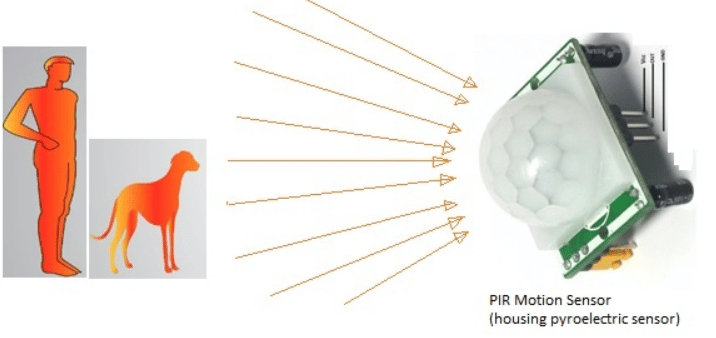When you purchase through links on our site, we may earn an affiliate commission. Here’s how it works.
What is a Motion Sensor?
Your home security system is most likely designed to detect an intrusion in your house.
This is when someone enters your home without permission, and as a result, your home security system will notify the monitoring center.
This is an integral part of any home security system, and it’s worth noting that the motion sensor is the device that detects and notifies the monitoring center.
So basically, a motion detector is an integral part of a home security system that detects and alerts the monitoring center when someone accesses your property.
If the sensor is triggered, it employs particular technologies to detect movement in the area and promptly sends a signal to your security system’s control panel.
Your monitoring center receives this signal, which indicates a probable threat in your house.
If this is unfamiliar territory for you, or if you know a bit about motion sensors and want to learn more, this article will offer you information about motion detectors, specifically how they interact with a home security system and general home automation.
Let’s get started!
How Do Motion Sensors Work?

What is a Motion Sensor? How Does It Work – How Do Motion Sensors Work
There are actually several kinds of motion sensors, and each of them functions on a slightly different standard. The various types of motion sensors include:
Microwave Sensors

Microwave Sensors
This is the second most common type of motion sensor, and it uses microwaves to monitor a space and detect movement. These detectors continually send microwaves, which hit items and bounce back to the sensor.
The sensor calculates the distance between these items by measuring their reflection rate. If anything moves, the item’s reflection rate changes, registering as a movement.
PIRs (Passive Infrared Sensors)

What is a Motion Sensor? How Does It Work – PIRs (Passive Infrared Sensors)
Infrared sensors gather infrared light, which is a wavelength of the electromagnetic spectrum that the human eye cannot see.
The detector itself comprises two independent sensors, each comprising a particular infrared-sensitive material.
These sensors are situated in a hermetically sealed metal structure behind a lens. The housing protects the sensors from humidity, noise, and temperature.
The ambient temperature of the space the detector is tracking is read by one of the two sensors. In other words, it generates a representation of how the area appears in normal circumstances.
The second sensor detects any unexpected temperature fluctuations in the area. Any discrepancy in what these two sensors see causes a pulse, which indicates ‘motion.’
As a result of this mechanism, PIRs (Passive Infrared Sensors) can only detect fast movement, such as temperature changes that occur rapidly enough to create a variance between the two sensors’ readings.
Most of these motion sensors are split into segments. The sections allow you to fixate on some aspects of a location while ignoring others.
As a result, detectors can be set to disregard certain types of movement or motion in certain zones.
In other words, sensors that feature segmentation capabilities will alert you if there is a home invasion but not when your cat strolls through your living room.
This feature makes customizable motion sensors a terrific addition to homes with pets.
Dual Sensors

What is a Motion Sensor? How Does It Work – Dual Sensors
At the moment, you can find detectors that feature both microwave and PIR technologies. The benefit of dual-tech sensors, as they are called, is that they verify one another.
Before the detector registers movement, both detectors must detect it first. This type of verification helps to avoid false alarms.
Other Types of Motion Sensors

What is a Motion Sensor? How Does It Work – Other Types of Motion Sensors
Area Reflective Sensors
Like PIR sensors, ARS sensors rely on infrared light to function. While PIR detectors are passive in that they gather infrared light, area reflective sensors are active.
Area reflective sensors emit infrared light pulses and detect how quickly the light bounces off of things.
Tomographic Sensors
Tomographic sensors are a relatively new concept in motion sensing. Rather than having one sensor, tomographic motion sensors comprise several nodes scattered across space.
Since these nodes interact with one another, anything that enters the field between them disrupts the links, signaling motion.
Tomographic sensors may be entirely hidden since they don’t depend on line of sight like other sensors. In addition, they can function through walls because they utilize radio waves.
Ultrasonic Sensors
Ultrasonic sensors function on the same principle as microwave sensors. Rather than bouncing microwaves off items, these sensors employ ultrasonic sound waves.
Vibration Sensors
Vibration sensors function by identifying small vibrations made by people as they walk.
Final Thought
You can use motion sensors in a number of ways, but their primary use is as security devices. Obviously, they alert you immediately if someone is in your home who shouldn’t be.
Once they’ve alerted you, you can contact emergency services for help.